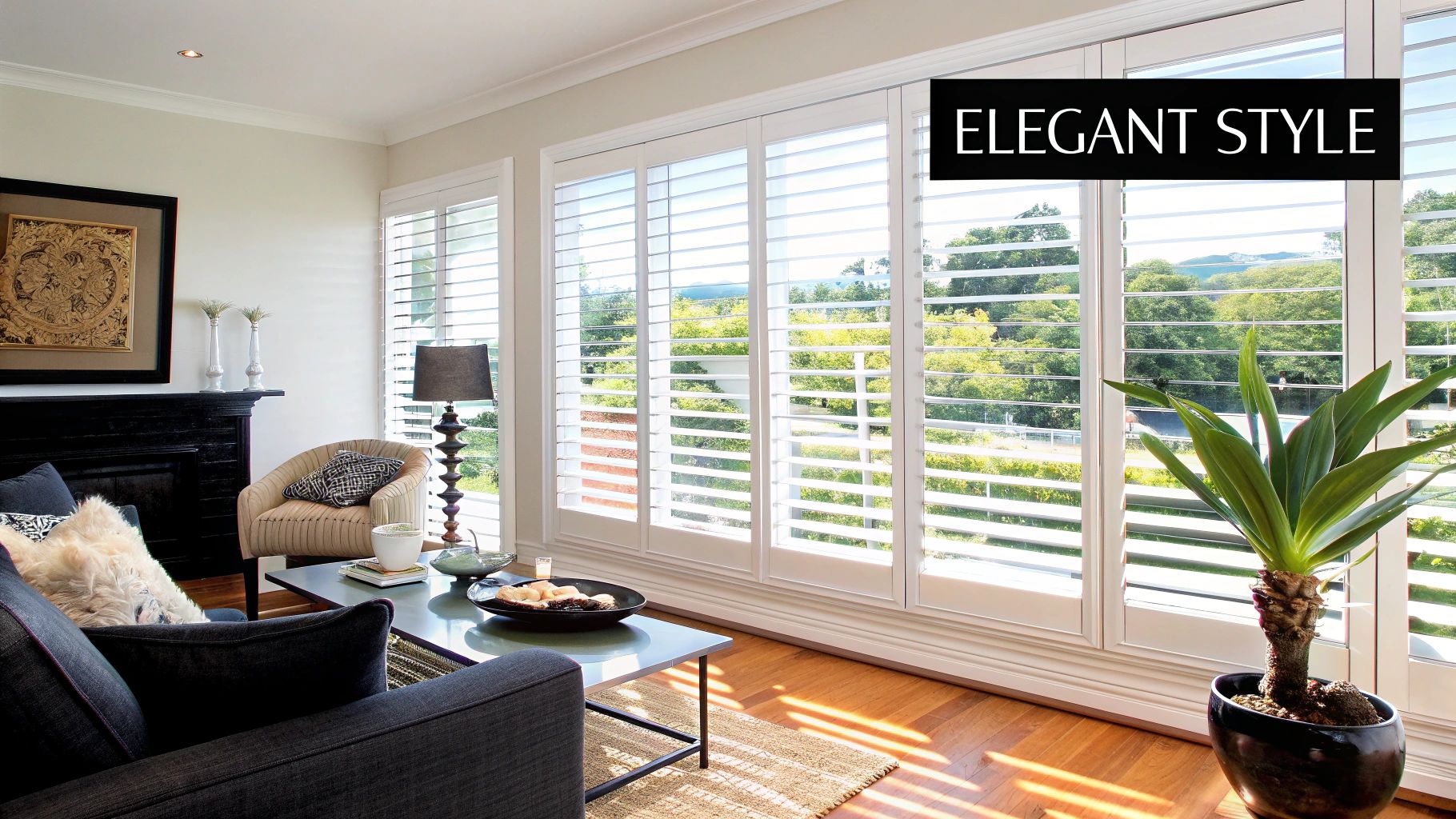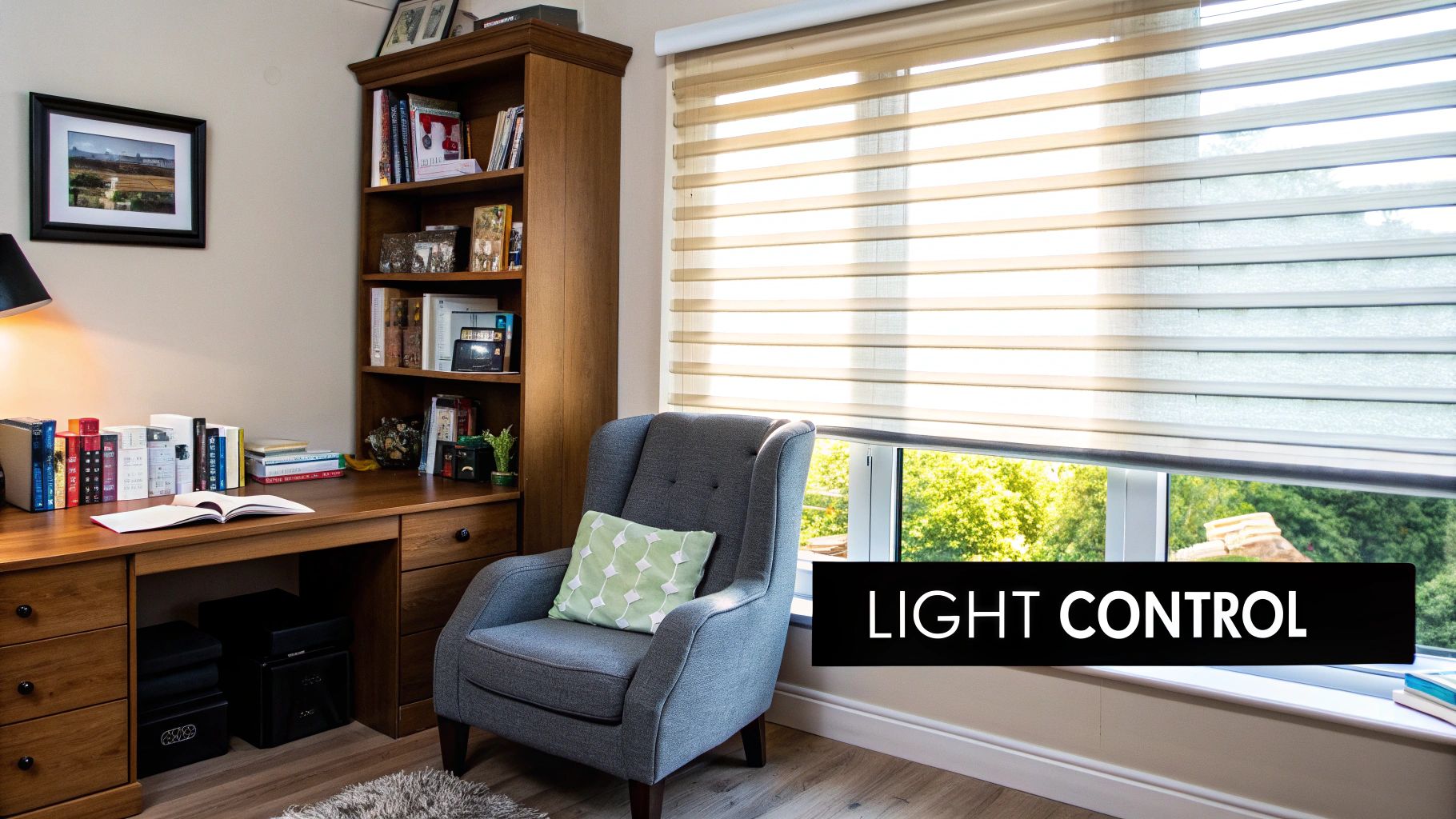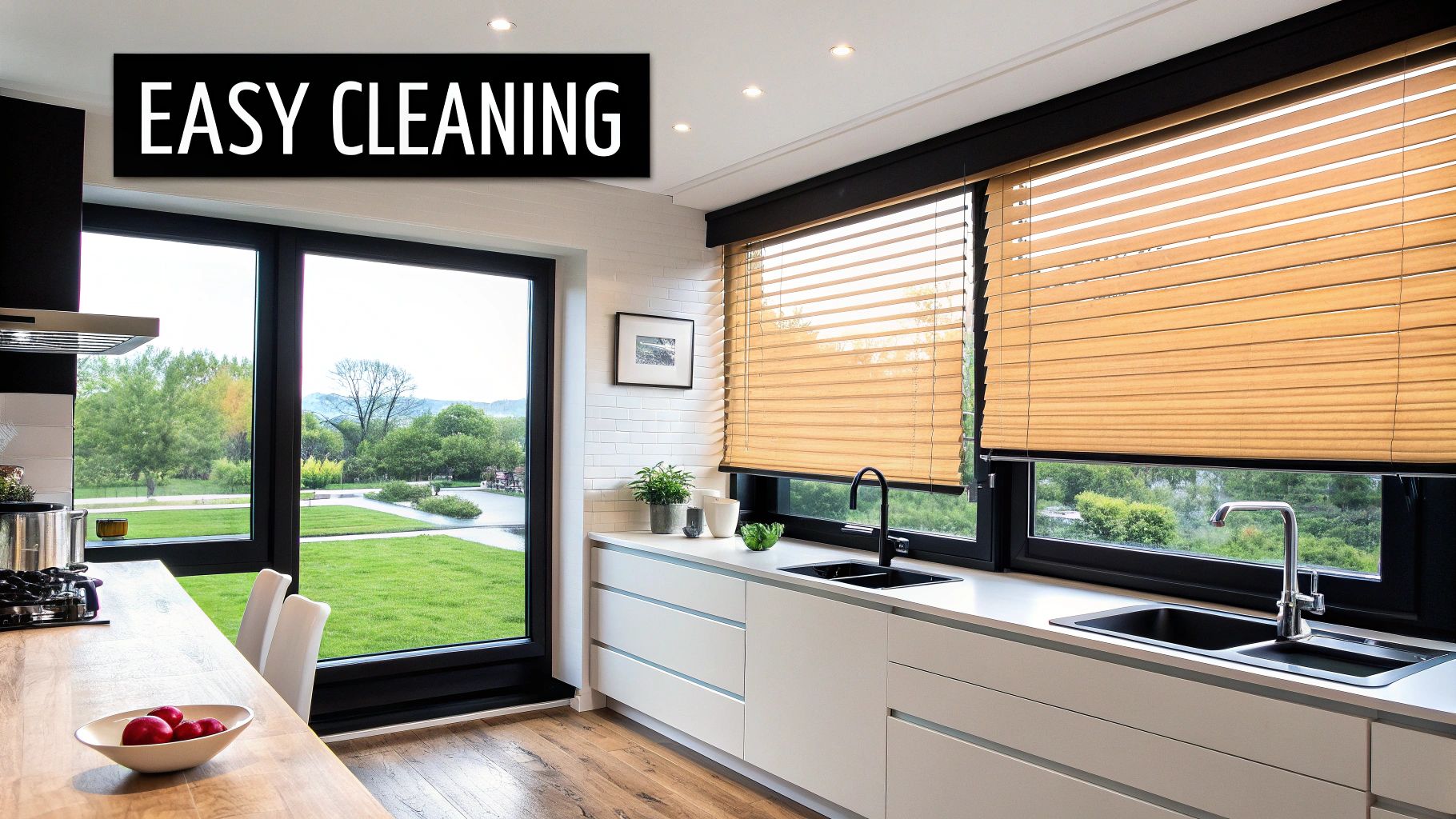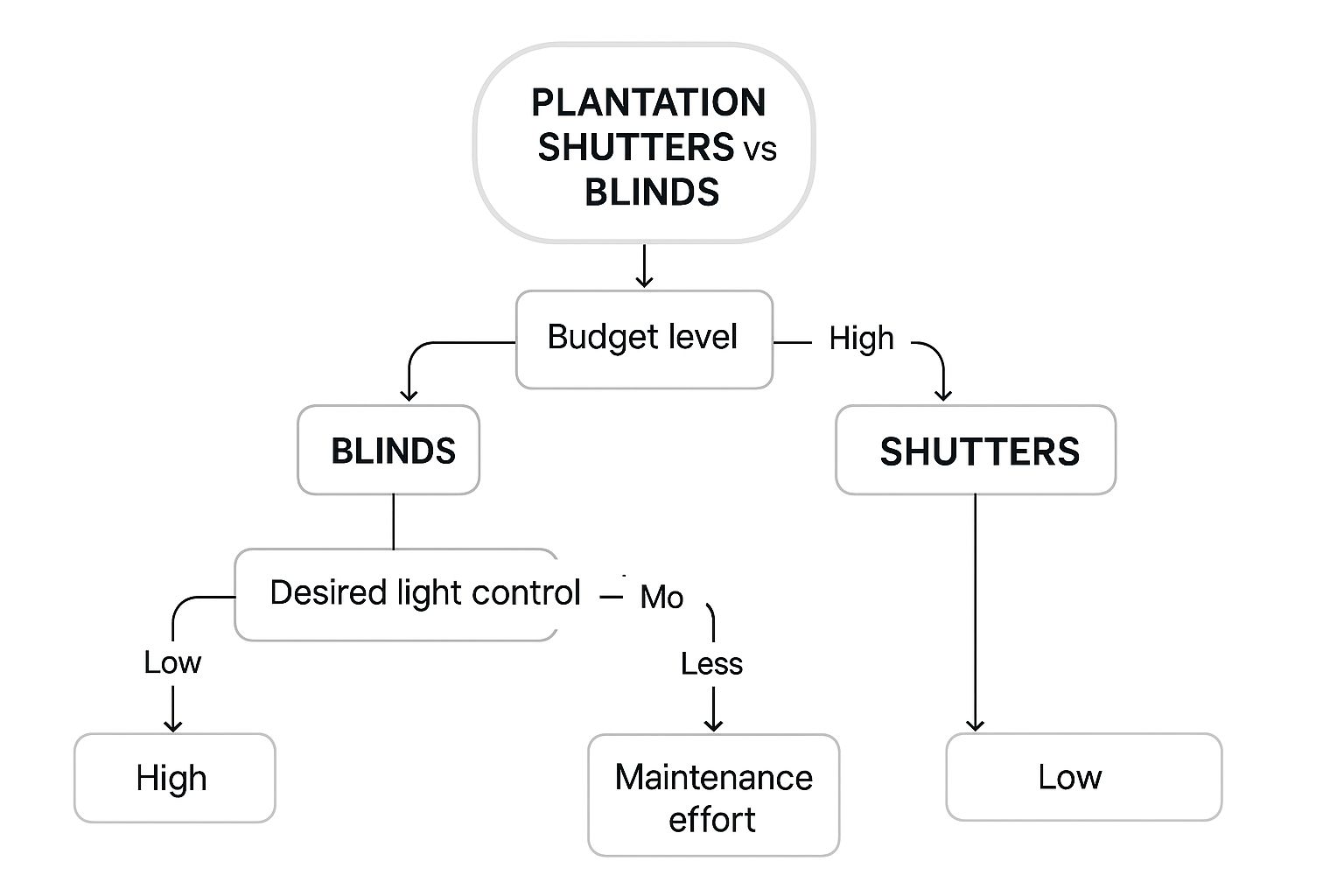Plantation Shutters Versus Blinds: Which Is Best for You?
- Johann Reardon

- Jul 18
- 11 min read
Understanding Your Window Treatment Investment Beyond The Sales Pitch
Choosing between plantation shutters and blinds goes far beyond simply picking a color you like. It's a long-term investment that impacts your home's comfort, value, and even your wallet in ways you might not expect. Let's skip the marketing hype and dive into the real-world differences that become apparent years after installation.
While blinds often seem cheaper upfront, their lifespan tells a different story. You'll likely need to replace them every 5-8 years, a recurring cost that adds up quickly. Plantation shutters, on the other hand, are designed for longevity, often lasting for decades. This durability makes them a valuable addition to your home, potentially increasing its resale value and offering a return on investment that blinds can’t match. If you're wrestling with the decision, this article offers some compelling points: Uncertain if you should choose blinds or shutters? 5 reasons why you should choose.
Material matters significantly when considering the long-term performance of your window treatments. Some blind materials might look good initially, but they are prone to warping or fading, especially with prolonged sun exposure. Plantation shutters, particularly those made from quality wood or composite materials, stand up to wear and tear much better, retaining their appearance and functionality over time. This translates to fewer repairs and replacements, saving you money and hassle in the long run.
The increasing popularity of plantation shutters underscores their enduring value. The global market for these window treatments was valued at USD 8.9 billion in 2023, with projections showing continued growth at a CAGR of 8.50% through 2030. This growth is fueled by increasing demand in regions like Europe and the Asia-Pacific. Discover more insights on the plantation shutters market.
Ultimately, choosing the right window treatment isn't about a simple price comparison. Think about long-term costs, material durability, and the impact on your home’s value. A well-informed decision now can save you from costly regrets later, ensuring you choose window treatments that truly fit your budget and lifestyle.
Material Performance That Actually Determines Your Experience

Let's face it: material claims in the window covering industry often don't translate to real-world performance. Lab tests rarely replicate the daily wear and tear of a busy household. Those "moisture-resistant" blinds? They might not hold up in a humid bathroom over time. This is a key distinction when comparing plantation shutters and blinds.
The material composition of composite shutters, especially the core, dramatically affects their longevity. Hollow core composites can dent easily in high-traffic areas, while solid cores provide much better impact resistance. Similarly, vinyl blinds, though budget-friendly, can warp in sunny, south-facing windows. Location matters as much as material.
Understanding Material Nuances
Wood plantation shutters, particularly those crafted from basswood or poplar, offer timeless appeal and excellent stability. However, they're more vulnerable to moisture damage than polypropylene or faux wood alternatives. Understanding these trade-offs is essential for making the right choice. For a deeper dive into room-specific considerations, check out this helpful guide: How To Choose Window Treatments: Expert Tips for Every Room.
To illustrate these real-world performance differences, let's look at a data-driven analysis:
Real-World Material Performance Analysis
Data-driven comparison based on actual homeowner experiences and installer observations across different environments and usage patterns
Material Type | Shutters Performance | Blinds Performance | Critical Applications | Realistic Lifespan |
|---|---|---|---|---|
Wood | Strong, stable, classic look | Susceptible to moisture, warping | Living rooms, bedrooms (low humidity) | 10-15 years |
Faux Wood/Polypropylene | Moisture-resistant, durable | Can fade in direct sunlight | Bathrooms, kitchens | 15-20 years |
Composite (Solid Core) | Impact-resistant, good stability | Less versatile in style | High-traffic areas, children's rooms | 15+ years |
Composite (Hollow Core) | Prone to dents, less durable | Cost-effective, lightweight | Low-traffic areas | 5-10 years |
Vinyl | Cost-effective, easy to clean | Can warp, become brittle | Budget-friendly option, short-term use | 3-5 years |
The table highlights the strengths and weaknesses of each material across common scenarios. Notice how lifespan expectations shift dramatically depending on both material and application.
Market Trends and Consumer Preferences
The continued popularity of wood shutters, holding a 46% market share in North America in 2021, speaks volumes about its desirable qualities. The strength-to-weight ratio and aesthetic appeal are key drivers. The global market for plantation shutters is also experiencing significant growth, projected to reach USD 1.56 billion by 2033, with a CAGR of 5.2% from 2026 to 2033. For more on market trends, see North America Plantation Shutters Market.
Ultimately, the best choice depends on your specific needs, environment, and budget. Selecting the right material now can save you from a costly replacement down the road. Choosing wisely means enjoying years of beautiful, functional window treatments.
The True Economics of Window Treatment Ownership

When choosing between plantation shutters and blinds, the initial price is only part of the story. The real cost unfolds over time, influenced by maintenance needs, energy efficiency, and how often they need replacing. Blinds may appear cheaper upfront, but their shorter lifespan often leads to more frequent purchases. This can add up, potentially exceeding the initial investment in longer-lasting plantation shutters.
Thinking long-term is key. Plantation shutters, though typically a larger initial expense, often last for decades with minimal upkeep. This results in a lower annual cost compared to blinds, which might require replacement every 5 to 8 years. The insulation provided by shutters can also lead to substantial energy savings, further balancing the higher upfront price. You might also be interested in comparing vinyl and aluminum blinds.
Calculating Your True Return on Investment
Return on investment extends beyond resale value, although plantation shutters often add to it. The real value lies in calculating the annual cost of satisfaction. This means factoring in energy savings, maintenance, and the product's lifespan. In certain situations, financing pricier shutters can be more economical in the long run than repeatedly buying and installing less expensive blinds.
Consider also the effect on your home's energy use. Plantation shutters significantly reduce heat loss during winter and heat gain in the summer. This results in lower energy bills year-round, a hidden benefit that increases their overall value. The initial cost can be partially offset by these reduced energy costs over the product's life.
Market trends reveal a growing awareness of these economic factors. The global blinds and shades market, while larger, shows slower growth. Valued at USD 6.78 billion in 2024, it's projected to reach USD 9.11 billion by 2032, with a CAGR of 3.55%. North America holds a significant portion of this market (50.58% in 2024), indicating an established preference for blinds and shades. Discover more insights about the blinds and shades market. This slower growth, relative to the plantation shutter market, hints at a possible shift toward the long-term advantages of more durable window treatments. A smart investment now can save money and hassle for years to come.
Let's take a closer look at the long-term costs:
To help illustrate this further, let's examine a cost comparison table:
Complete Ownership Cost Reality Check Comprehensive analysis including hidden costs, maintenance realities, and replacement patterns based on actual homeowner experiences
Cost Category | Plantation Shutters | Quality Blinds | 10-Year Reality | Annual Impact |
|---|---|---|---|---|
Initial Purchase | $2,500 | $500 | ||
Installation | $200 | $100 | ||
Maintenance (Cleaning, Repairs) | $100 (over 10 years) | $50 (every 2 years) | $250 | $25 |
Replacement | $0 (10+ year lifespan) | $500 (every 5-7 years, assumed once in 10 years) | $500 | $50 |
Energy Savings (estimated) | $50 annually | $20 annually | $500 | $50 |
Total 10-Year Cost | $2,800 | $1,350 | ||
Annualized Cost | $280 | $135 | ||
Net Annual Impact (including energy savings) | $230 | $115 |
This table demonstrates how, over time, the higher initial cost of plantation shutters can be offset by lower maintenance and replacement costs, coupled with energy savings. While blinds may have a lower annualized cost initially, the need for replacements and higher maintenance costs over a 10-year period often negate those initial savings. The accumulated impact highlights the long-term economic benefits of choosing plantation shutters. Remember, these figures are estimates, and your specific situation will vary. Factors such as climate, window size, and usage patterns will influence the actual cost.
Daily Living Realities That Nobody Talks About
Choosing between plantation shutters and blinds goes beyond the surface level of aesthetics and initial price tags. It's about how these window treatments truly function within the rhythm of your everyday life. Talking to homeowners, from busy families to remote workers and empty nesters, reveals practical nuances often missed in showroom brochures.
Consider noise reduction, for instance. In a home office, the solid structure of plantation shutters can create a surprisingly quieter workspace compared to blinds, dampening street noise and neighborhood chatter. This can be a significant factor for those working from home or seeking a peaceful retreat. Thinking about the long-term value of this investment is wise, much like comparing a CD to a savings account. This resource offers helpful context: savings account vs cd.
Ease of operation is another key consideration. For individuals with arthritis or limited mobility, the sturdy louvers of plantation shutters are generally easier to manipulate than the sometimes flimsy slats of blinds. This seemingly minor detail can have a real impact on daily comfort and independence.
Pet owners face unique challenges. Dangling blind cords can be a tempting hazard for curious pets. While cordless blind options exist, they often come with a higher price. Plantation shutters, inherently cord-free, eliminate this risk entirely, offering peace of mind.
Child safety is paramount. Blind cords pose a strangulation risk to young children. Safety devices can help, but they can also be awkward to use. The cord-free design of plantation shutters provides an intrinsically safer solution, easing a significant worry for parents.
The morning rush highlights further functional differences. Quickly adjusting plantation shutters is often simpler than wrestling with tangled blind cords. During video calls, the consistent light control offered by shutters helps prevent glare and distractions, ensuring a professional appearance.
Material choices introduce their own set of practicalities. Certain blind materials can be dust magnets, demanding frequent cleaning. Shutters, while generally easier to clean, can still accumulate dust in the louver crevices. Unexpected benefits, like improved air circulation with certain shutter styles, might only become apparent through daily use.
Ultimately, the best choice depends on your individual lifestyle and priorities. By considering these daily living realities, you can move beyond the initial sales pitch and make a more informed decision that truly enhances your home and your life.
Installation Truths and Professional Requirement Realities

Installation marks the crucial final stage of your window treatment project. Regardless of whether you’ve opted for plantation shutters or blinds, a subpar installation can completely undermine the quality of the product. This frequently overlooked step can transform a simple home improvement into a significant problem. Conversations with seasoned installers reveal some key insights for lasting satisfaction.
For instance, certain window shapes, like arches or bay windows, practically necessitate professional installation for both shutters and blinds. DIY attempts with these unique shapes often result in ill-fitting treatments and compromised functionality. Accurate measurements are paramount. Even minor errors can create significant issues, leading to gaps, uneven operation, and an unprofessional look. When considering window treatments, remember overall home safety is key, much like when using candles. Be sure to review candle safety tips to maintain a safe and inviting home.
Identifying Qualified Installers
Finding a skilled installer requires more than just seeking the lowest price. Asking the right questions can help differentiate experienced professionals from less qualified individuals. Inquire about their experience with specific window types and materials. A knowledgeable installer will grasp the nuances of how different products interact with various window frames. You might find this helpful: Check out our guide on motorized blinds DIY installation. Also, discuss realistic timelines. Experienced installers account for potential delays due to material availability or unexpected issues, providing accurate expectations from the outset.
Avoiding Installation Pitfalls
Proactively identifying potential problems is crucial. Inspect the installation as it progresses. Check for gaps between the treatments and the window frame, uneven louver alignment in shutters, or any difficulty in smoothly operating the blinds. Addressing these seemingly small issues promptly can prevent major frustrations down the line.
Ensure the installer uses the correct hardware and mounting techniques for your specific window type and wall material. Using the wrong hardware can lead to instability and potentially damage your walls. Finally, understand your warranty coverage. A reputable installer will back their work, offering guarantees against defects or installation errors. By focusing on these installation aspects, you can ensure your chosen window treatments—whether plantation shutters or blinds—look and function beautifully for years to come.
Design Integration Beyond Pinterest Perfect
Choosing between plantation shutters and blinds goes beyond simply finding attractive pictures online. Successfully incorporating them into your home involves understanding how they interact with your existing architecture, design elements, and even your lifestyle. This is where the true design challenge begins.
Consider a Craftsman-style bungalow, for instance, with its characteristic woodwork and warm, earthy color palette. Plantation shutters, especially in natural wood stains, can beautifully complement this aesthetic, mirroring the architectural details. In contrast, sleek, modern blinds might feel jarring against the bungalow's traditional character. Similarly, in a minimalist, contemporary space, brightly colored blinds could introduce a vibrant pop of personality, while ornate plantation shutters could seem out of place.
Color selection significantly impacts a room’s perceived size. Dark blinds can make a large window feel smaller and cozier. Lighter shutters can visually enlarge a smaller room, maximizing the effect of natural light. Just like choosing window treatments, even seemingly simple tasks like hanging holiday lights require planning and the right equipment. For helpful tips, check out this article on how to hang Christmas lights.
Hardware and Light Distribution: The Unsung Heroes of Design
Hardware is often an afterthought, yet it significantly influences the overall design. Oil-rubbed bronze hinges on plantation shutters can enhance rustic or traditional interiors. Brushed nickel hardware on blinds can contribute to a more modern or industrial look. These seemingly minor details connect the window treatments to the broader room design.
How each option manages natural light also plays a crucial role. Plantation shutters, with their adjustable louvers, provide precise light control, creating interesting shadow play throughout the day. Blinds, particularly sheer or light-filtering options, diffuse light softly, establishing a calm atmosphere. This affects not only the room's appearance but also its overall feel.
Resale Appeal: A Long-Term Design Consideration
Finally, think about your home’s resale value. Classic choices, like neutral-colored plantation shutters, tend to age well and appeal to a wider range of potential buyers. Trendy blind patterns or colors, while appealing now, may quickly date your home. This is comparable to how specific kitchen or bathroom fixtures can influence a home’s perceived worth.
Effective design integration lies in understanding these subtle but significant relationships. It's about building a unified look that enhances your existing style and improves your home's overall character. By carefully weighing these factors, you can make decisions that not only look fantastic today but also remain appealing for years to come.
Making Your Decision With Confidence and Clarity
This infographic offers a simplified look at choosing between plantation shutters and blinds. It focuses on budget, light control, and how much effort you want to put into maintenance.

As you can see, if your budget is tight, you need moderate light control, and easy maintenance is a must, blinds are a good starting point. If precise light control and low maintenance are priorities, and you have more room in your budget, plantation shutters might be a better fit. This infographic is just the beginning though. A truly informed decision needs more thought.
This screenshot from Home Depot shows just how many window treatments are out there. It can feel overwhelming.

With so many choices, it’s important to know what you need and what’s important to you. Making the right choice takes more than just clicking around online; it means really thinking about the things we’ve talked about in this guide.
Evaluating Quotes and Installers
Now that you understand the differences between plantation shutters and blinds, looking at quotes is about more than just the price tag. A lower quote isn’t always the best deal. Look closely at the materials listed, the warranty, and the installer's experience. A good installer will happily answer your questions and clearly explain all the costs, including installation.
Avoiding Buyer's Remorse
The secret to avoiding buyer’s remorse? Make sure your choice fits your lifestyle, budget, and long-term plans. If you need a budget-friendly option for a rental, expensive plantation shutters are probably overkill. But, if you're fixing up your forever home, the durability and long-term value of shutters might be worth the higher initial cost. For more on the benefits of shutters, check out this article: What are the benefits of Norman Shutters for your home?
Making a decision you feel good about means asking yourself the right questions. Is energy efficiency important to you? What about noise reduction? How much control over light do you really need? Being honest with yourself about these things will help you see which option is truly right for you.
Think about these practical points, have realistic expectations, and understand the long-term effects of your choice. This will help you make a smart decision that you’ll be happy with for years to come.
Ready to update your home with beautiful, functional window treatments? Contact Home Blinds and Floors today for a free consultation and find the perfect solution for you.

.avif)
Comments